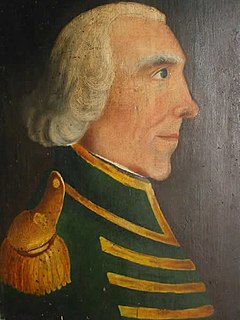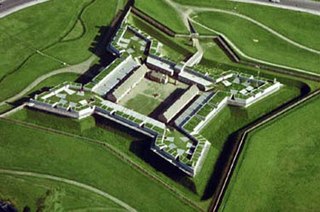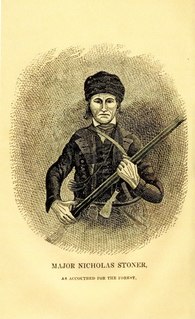
The 1779 Sullivan Expedition was a United States military campaign during the American Revolutionary War, lasting from June to October 1779, against Loyalists and the four British allied Nations of the Iroquois. The campaign was ordered by George Washington, in response to the 1778 Iroquois–British attacks on Wyoming, German Flatts and Cherry Valley, with the aim of "taking the war home to the enemy to break their morale". The Continental Army carried out a scorched-earth campaign, chiefly in the lands of the Iroquois Confederacy in what is now Pennsylvania and western New York state.

The Battle of Oriskany was a significant engagement of the Saratoga campaign of the American Revolutionary War, and one of the bloodiest battles in the conflict between the Americans and Great Britain. On August 6, 1777, a party of Loyalists and several hundred Indian allies across several nations ambushed an American military party that was marching to relieve the siege of Fort Stanwix. This was one of the few battles in which the majority of the participants were Americans; Rebels and allied Oneidas fought against Loyalists and allied Iroquois in the absence of British regular soldiers. There was also a detachment of Hessians in the British force, as well as Western Indians including members of the Mississaugas people.

John Butler (1728–1796) was a Loyalist who led an irregular militia unit known as Butler's Rangers on the northern frontier in New York during the American Revolutionary War. Born in Connecticut, he moved to New York with his family, where he learned several Iroquoian languages and worked as an interpreter in the fur trade. He was well-equipped to work with Mohawk and other Iroquois Confederacy warriors who became allies of the British during the rebellion.

Butler's Rangers (1777–1784) was a Loyalist provincial military unit of the American Revolutionary War, raised by American loyalist John Butler. Most members of the regiment were Loyalists from upstate New York. Their winter quarters were constructed on the west bank of the Niagara River, in what is now Niagara-on-the-Lake, Ontario. The Rangers fought principally in Western New York and Pennsylvania, but ranged as far west as Ohio and Michigan and as far south as Virginia.

The Cherry Valley massacre was an attack by British and Iroquois forces on a fort and the village of Cherry Valley in central New York on November 11, 1778, during the American Revolutionary War. It has been described as one of the most horrific frontier massacres of the war. A mixed force of Loyalists, British soldiers, Seneca and Mohawks descended on Cherry Valley, whose defenders, despite warnings, were unprepared for the attack. During the raid, the Seneca in particular targeted non-combatants, and reports state that 30 such individuals were slain, in addition to a number of armed defenders.

The Battle of Wyoming was an encounter during the American Revolutionary War between American Patriots and Loyalists accompanied by Iroquois raiders. The clash took place in the Wyoming Valley of Pennsylvania on July 3, 1778, in Exeter and Wyoming, Pennsylvania. More than 300 Patriots were killed in the battle.

Adam Frederick Helmer, also known as John Adam Frederick Helmer and Hans Adam Friedrich Helmer, was an American Revolutionary War hero among those of the Mohawk Valley and surrounding regions of New York State. He was made nationally famous by Walter D. Edmonds' popular 1936 novel Drums Along the Mohawk with its depiction of "Adam Helmer's Run" of September 16, 1778, to warn the people of German Flatts of the approach of Joseph Brant and his company of Indians and Tories.

Colonel Marinus Willett was an American military officer, politician and merchant who served as the mayor of New York City from 1807 to 1808. Willett is best known for his actions during the American Revolution, where he served as an important Patriot leader in colonial New York before enlisting in the Continental Army and serving in numerous campaigns in the Revolutionary War throughout the Northwest.
Walter Butler was a British Loyalist officer during the American Revolution. He was born near Johnstown, New York, the son of John Butler, an Indian agent who worked for Sir William Johnson. Walter Butler studied law, and became a lawyer in Albany, New York.

The King's Royal Regiment of New York, also known as Johnson's Royal Regiment of New York, King's Royal Regiment, King's Royal Yorkers, and Royal Greens, were one of the first Loyalist regiments, raised on June 19, 1776, in British Canada, during the American Revolutionary War.

The Northern theater of the American Revolutionary War after Saratoga consisted of a series of battles between American revolutionaries and British forces, from 1778 to 1782 during the American Revolutionary War. It is characterized by two primary areas of activity. The first set of activities was based around the British base of operations in New York City, where each side made probes and counterprobes against the other's positions that sometimes resulted in notable actions. The second was essentially a frontier war in Upstate New York and rural northern Pennsylvania that was largely fought by state militia companies and some Indian allies on the American side, and Loyalist companies supported by Indians, British Indian agents, and occasionally British regulars. The notable exception to significant Continental Army participation on the frontier was the 1779 Sullivan Expedition, in which General John Sullivan led an army expedition that drove the Iroquois out of New York. The warfare amongst the splinters of the Iroquois Six Nations were particularly brutal, turning much of the Indian population into refugees.
The Battle of Klock's Field, also called the Battle of Failing's Orchard; and occasionally the Battle of Nellis Flatts or the Battle of Stone Arabia, was an encounter between elements of New York colonial militia and a British-supported expedition of Indians and Loyalists led by Lieutenant Colonel Sir John Johnson and Captain Joseph Brant.

The Attack on German Flatts was a raid on the frontier settlement of German Flatts, New York during the American Revolutionary War. The attack was made by a mixed force of Loyalists and Iroquois under the overall command of Mohawk leader Joseph Brant, and resulted in the destruction of houses, barns, and crops, and the taking of livestock for the raiders' use. The settlers, warned by the heroic run of Adam Helmer, took refuge in local forts but were too militarily weak to stop the raiders.

The siege of Fort Stanwix in 1777 began on August 2 and ended August 22. Fort Stanwix, in the western part of the Mohawk River Valley, was then the primary defense point for the Continental Army against British and Indian forces aligned against them in the American Revolutionary War. The fort was occupied by Continental Army forces from New York and Massachusetts under the command of Colonel Peter Gansevoort. The besieging force was composed of British regulars, American Loyalists, Hessian soldiers from Hesse-Hanau, and Indians, under the command of British Brigadier General Barry St. Leger and the Iroquois leader Joseph Brant. St. Leger's expedition was a diversion in support of General John Burgoyne's campaign to gain control of the Hudson River Valley to the east.

Tryon County was a county in the colonial Province of New York in the British American colonies. It was created from Albany County on March 24, 1772, and was named for William Tryon, the last provincial governor of New York. The county's boundaries extended much further than any current county. Its eastern boundary with the also-new Charlotte County ran "from the Mohawk River to the Canada line, at a point near the old village of St. Regis and passing south to the Mohawk between Schenectady and Albany." It extended north to the St. Lawrence River; its western boundary was the Treaty of Fort Stanwix's Line of Property, following the Unadilla River, Oneida Lake, Onondaga River and Oswego River to Lake Ontario, as the Iroquois Confederacy still controlled locations further west in the Indian Reserve. Tryon County's seat was Johnstown, which is today the county seat of Fulton County. The Tryon County Courthouse, built in 1772–1773, was listed on the National Register of Historic Places in 1972. The Tryon County Jail, also built in 1772–1773, was listed on the National Register of Historic Places in 1981.

The Raid on Unadilla and Onaquaga was a series of military operations by Continental Army forces and New York militia against the Iroquois towns of Unadilla and Onaquaga in what is now upstate New York. In early October 1778, more than 250 men under the command of Lieutenant Colonel William Butler of the 4th Pennsylvania Regiment descended on the two towns and destroyed them, razing most of the buildings and taking or destroying provisions, including the people's winter stores.

Colonists who supported the British cause in the American Revolution were Loyalists, often called Tories, or, occasionally, Royalists or King's Men. George Washington's winning side in the war called themselves "Patriots", and in this article Americans on the revolutionary side are called Patriots. For a detailed analysis of the psychology and social origins of the Loyalists, see Loyalist.

Nicholas Stoner was a hunter and trapper in the Adirondack Mountains of New York. He served in the Continental Army in the American Revolution and the American forces in the War of 1812. He is buried in Prospect Hill Cemetery, Gloversville, New York.

John Ross (1744–1809) was a British Army officer in the French and Indian War and the American Revolution. He is best known for commanding a mixed force of approximately 600 regulars, Loyalists, and Indians in a raid into upstate New York on October 24, 1781 that culminated in the Battle of Johnstown, one of the last battles in the northern theater of the American Revolution. After the war, Ross was instrumental in settling Loyalist refugees in what is now the Kingston area of eastern Ontario.
John Doxtader (1760–1801) was a Loyalist in the American Revolution and an officer in British forces. He is best known for commanding the "Invasion of Currytown" in the Mohawk Valley on July 9, 1781. His name is variously spelled Dachstädter, Dachsteder, Docksteder, Dochsteder, etc.

















